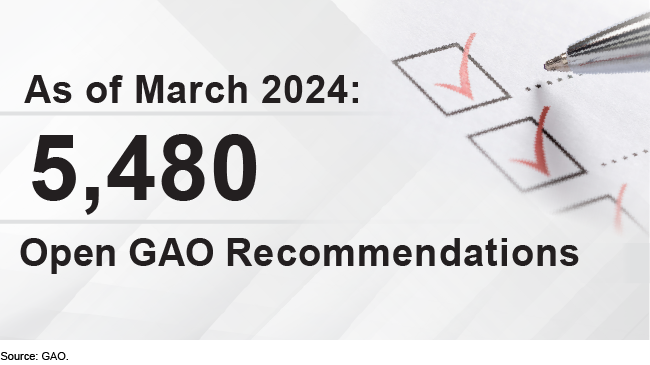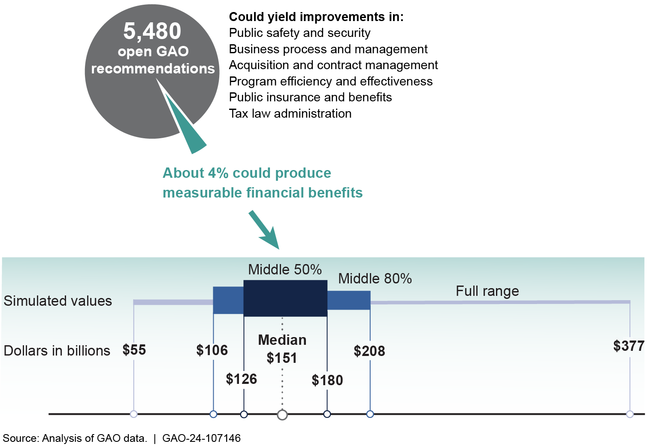Open GAO Recommendations: Financial Benefits Could Be Between $106 Billion and $208 Billion
Fast Facts
GAO routinely makes 1,200 or more recommendations each year to assist Congress and improve government performance. Typically, over 75% of GAO's recommendations are implemented—i.e., "closed." Many of these recommendations are intended to save money and enhance revenue.
Because GAO makes recommendations on an ongoing basis, there is always an inventory of open recommendations. As of March 2024, 5,480 GAO recommendations were open. We estimate that implementing some of these recommendations could produce measurable financial benefits of $106 to $208 billion.

Highlights
What GAO Found
GAO routinely makes 1,200 or more recommendations each year to assist Congress and improve government performance. Many of these recommendations are intended to save money and enhance revenue. Many more are to strengthen national security, enhance public health and safety, and improve the efficiency and effectiveness of government programs and operations. They also help Congress refine and create laws framing federal policies across the spectrum of the government's responsibilities. Typically, over 75 percent of GAO's recommendations are implemented. GAO continuously works with Congress and federal agencies to follow up on open recommendations to achieve the intended results.
Because GAO makes new recommendations on an ongoing basis, there is always an inventory of open recommendations. As of March 2024, 5,480 GAO recommendations were open. These recommendations cover six categories, as shown in the figure. A subset of these recommendations (about 4 percent) could produce measurable financial benefits between $106 billion and $208 billion through increased revenues or reduced expenditures, according to GAO's simulation.
Potential Benefits of Open GAO Recommendations as of March 2024

GAO used a simulation to estimate total potential financial benefits because a lack of data and other factors make it challenging to precisely calculate the total potential financial benefits of each open recommendation. Also, it is difficult to predict how management would use its discretion in implementing the recommendations. More specific estimates exist for a small subset of these recommendations. In its annual report on duplication and cost savings, GAO identified 19 recommendations with potential financial benefits of $1 billion or more, many of which are described in that report (GAO-24-106915). Several are highlighted in the table below.
Examples of Open Recommendations with Potential Financial Benefits of $1 Billion or More
|
Open recommendation (GAO report number linked) |
Potential financial benefits (source) |
|---|---|
|
*Medicare Payments by Place of Service: Congress could realize additional financial benefits if it took steps to direct the Secretary of Health and Human Services to equalize payment rates between settings for evaluation and management office visits and other services that the Secretary deems appropriate. (GAO-16-189) |
$141 billion over 10 years (Congressional Budget Office) |
|
COVID-19 Employer Tax Relief: The Internal Revenue Service (IRS) should document processes used to address certain compliance risks for COVID-19 employer tax credits and implement additional compliance activities to potentially recapture ineligible claims. (GAO-22-104280) |
Tens of billions of dollars over 2 years (GAO analysis of IRS data) |
|
*Public-Safety Broadband Network: Congress should consider reauthorizing FirstNet, including different options for its placement, and ensure key statutory and contract responsibilities are addressed before current authorities sunset in 2027. (GAO-22-104915) |
$15 billion over 15 yearsa (GAO analysis of the FirstNet Contract) |
|
Student Loan Income-Driven Repayment Plans: The Department of Education should obtain data to verify income information for borrowers reporting zero income on Income-Driven Repayment applications. (GAO-19-347) |
More than $2 billion over 10 years (Congressional Budget Office) |
|
*Department of Energy's Treatment of Hanford's Low-Activity Waste: Congress should consider clarifying two issues, including the Department of Energy's (DOE) authority to determine whether portions of Hanford's tank waste, such as the low-activity tank waste, can be managed as a waste type other than high-level radioactive waste and disposed of outside the state of Washington. (GAO-22-104365) |
Billions of dollars over 11 years (GAO analysis of DOE data) |
|
*Improper Payments and Fraud: Congress should establish a permanent analytic center of excellence to aid the oversight community in identifying improper payments and fraud. (GAO-22-105715) |
More than $1 billion annually (GAO analysis of agency data) |
Legend: * = Legislation is likely to be necessary to fully address all matters or recommendations in this topic area.
Source: GAO. | GAO-24-107146
aIf FirstNet sunsets, it is unclear what will happen to the remaining $15 billion in scheduled annual payments, which FirstNet currently has authority to collect and reinvest.
Note: The examples in the table above are based on GAO's body of work on Duplication and Cost Savings (see GAO- 24-106915) and are derived from methodologies and data that can be specific to each recommendation. In contrast, GAO's simulation uses a uniform methodology, based on data from thousands of GAO's realized financial benefits, to estimate the total potential financial benefits from all current open recommendations. Because these methods are not comparable the simulation results will not match the individual estimates of specific recommendations. See appendix I of this report for more details.
Some of GAO's recommendations are directed to Congress. As of March 2024, bills introduced in the 117th and 118th Congresses would have fully or partially addressed 103 of the 242 open recommendations GAO has made to Congress (about 43 percent).
Why GAO Did This Study
Since fiscal year 2002, GAO's work has resulted in over $1.38 trillion in financial benefits. In addition, over 28,000 program and operational benefits have occurred that helped to change laws, improve public safety, and promote sound management throughout government. In fiscal year 2023 alone, GAO's work generated about $70.4 billion in financial benefits.
The Senate report accompanying the Legislative Branch Appropriations Act, 2024, included a provision for GAO to provide additional detail on the potential financial benefits associated with open GAO recommendations to federal agencies and matters to Congress. This report updates GAO's previous estimated ranges of potential financial benefits, both in total and for selected agencies and Congress, which could result from implementation of all open GAO recommendations.
To estimate ranges of potential financial benefits, GAO developed simulation models using GAO's historical data on recommendations and realized financial benefits. To ensure a sufficient number of open recommendations for each simulation, GAO selected the 10 entities—nine agencies and Congress—with the largest number of open recommendations. GAO identified and mitigated limitations related to using the historical data for the simulation model by testing several alternatives. Actual financial benefits will depend on whether, how, and when recommendations are addressed.
For more information, contact Jessica Lucas-Judy at (202) 512-6806 or lucasjudyj@gao.gov or Michael Hoffman at (202) 512-6445 or hoffmanme@gao.gov.
